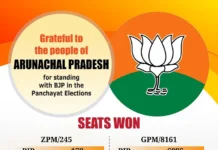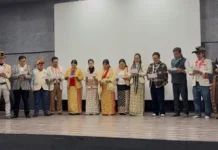[ S Mundayoor ]
Several districts of Arunachal have been celebrating the National Reading Week with a variety of programmes. What is the relation between the National Reading Week and the first national public exam the CBSE Class 10 an Arunachal student writes? Elementary, you would say, those who are reading proficient, will score well…. Then, where do our government schools stand? Is there anything that we can immediately put into practice to give our students the confidence to emerge with a smile after their CBSE exams?
As a library activist, this writer has been closely observing the English reading patterns and styles of primary and middle school students of government schools for over a quarter of a century. Here are a few time-tested practices which have been effectively used by volunteers of the Lohit youth library movement to stimulate reading skills of government school students over the last 16 years.
Model loud reading: It is universally accepted that only by hearing the patterns of how a language sounds can the skills of speaking and reading can be transferred from a speaker to a new learner. Hence, in all reading societies, elders have been reading out to the young through storytelling, poetry and rhyme recitation and book reading: Till the dawn of this century, it was common to see it being practised at homes early morning, afternoon or very popularly at the children’s bedtime. Arunachal’s early generations of students, all hostellers, would remember with nostalgia the story sessions many of their teachers used to conduct at night. In the dim light of the lantern, the stories evoked surreal feelings in the young minds. Several luminaries like Gandhiji, Tagore and Swami Vivekananda have openly acknowledged the benefit of these sessions of ‘adult time’ that they received in their childhood and the transformation these sessions could bring about in their personalities.
Even in adult education, as in learning foreign languages like German and French, the listening to loud reading sessions is practised with great attention. The recent success of thousands of Indian university students finding a seat in the hotly favoured German universities, with a fully funded scholarship is an instance. Here is ample proof that listening attentively and practising to speak and read aloud a ‘foreign’ language brings proficiency in that language and academic success.
What have we been offering to our students in Arunachal government primary and middle schools? As day scholars, with just 3-4 hours of school exposure to English, can they ever dream of acquiring confidently reading skills in English? A Class 11 government school student’s recent remark was thought-provoking: “The only English word I learnt upto Class 5 in my primary school is ‘Because’.”
Have our primary and middle schools and teachers been giving their students the essential read-aloud exposure to English, our state’s medium of instruction? Again, we can recall that daily reading aloud for a few minutes by every teacher was a common and regular practice in our government schools in the ’70s and the ’80s, whether class was English, or science, or social studies. Such reading aloud by a teacher, with voice modulation, pause and intonation, almost like normal speech, greatly strengthened the reading style of the students when they later did it alone.
The regular model loud reading by the teacher greatly familiarised even our rural students to the intricacies of English pronunciation and exposed them to a large range of vocabulary. This writer remembers once primary school children exclaiming “Fantastic!” during an evening volleyball match.
Loud reading drill: This was another important practice in language acquisition, which seems to have vanished from a large number of our classrooms. Unfortunately, even when a reading drill is practised, especially in Classes 1 to 3, it is done word by word, slow and dragging, which prevents the young child from building a mental impression of the sentence and the entire passage. This is a totally wrong practice, against all principles of a second/third language learning. To draw an analogy, it is as if driving a vehicle in first gear on a grand national highway, just to ensure that every metre of the road is negotiated smoothly.
Later, when the student starts reading aloud a passage on their own, it emerges as a mechanical production of sounds, and they are not able to convey the spirit of the passage to the listeners. It also cripples the child’s efforts to speak the language fluently in real-life situations.
Another undesirable practice seen in many students is to put their finger below each word before pronouncing it. This could have got reinforced by the ignorance of some adults who insist on the children to imbibe this wrong practice.
As the school system slowly emerged out of the crippling effect of the Covid, it was a clear-cut feeling across the country that we needed a mission mode approach to rev up the paralysed reading skills of the primary and middle school students. The Bamboosa Library, the headquarters of the Lohit Youth Library Network, has therefore been doing, for the last one year, a stream of read aloud programmes for readers as well as teacher-volunteers. These efforts – voluntary, free and after school hours – for interested students of Tezu town has produced, over the last one year, a remarkable enthusiasm in the government middle school students to explore new books in the library and have improved their reading aloud skills. (AIR North East Service, 15 Dec, 2022 – A news roundup on RASA programme by Bamboosa Library Tezu https://youtu.be/MCfbfSwAOpw)
The time has come for our state education department and the district authorities to declare a war on reading deficiency of our primary and middle school students. This would need:
- Clear and binding instructions by the education department to all teachers to devote a few minutes in every class, every day, to do reading aloud a part of their lesson, the teacher thus providing a role model.
- To do daily read-aloud drill of various passages from textbooks for the students.
- Utilise the Saturday creativity session to read aloud to the students, library and story books. Practise ‘reading theatre’ with students reading aloud the dialogues in a play. Teacher can prepare dialogues of a story from the textbook or use readily available pictorial comics like Amar Chitra Katha or Tinkle.
- The district officials and others like VEC members to do surprise visits to observe the effective performance of these activities.
A committed effort in this direction by any school or any class can produce wonderful results within a year. Over the years, the cumulative effect of this intervention will be exponential. This indeed is an important step not only to bring about an impressive CBSE Class 10 results in our government schools, but to help build a reading Arunachalee society in the next decade. (The writer is a reader activist involved in spreading the joy of reading among Arunachalee youths for over four decades. He is the coordinator of Lohit Youth Library Network, Arunachal Pradesh; academic adviser, RIWATCH, Roing; and adviser, RPETA Trust, New Delhi. Email id: lohit.libraries2023@gmail.com)





